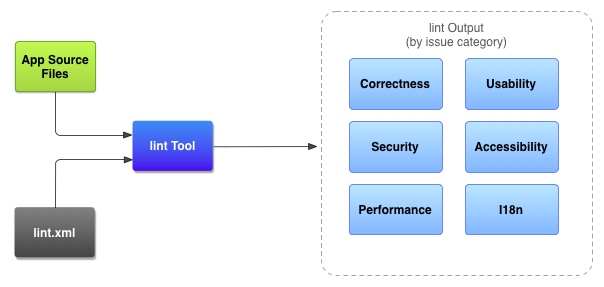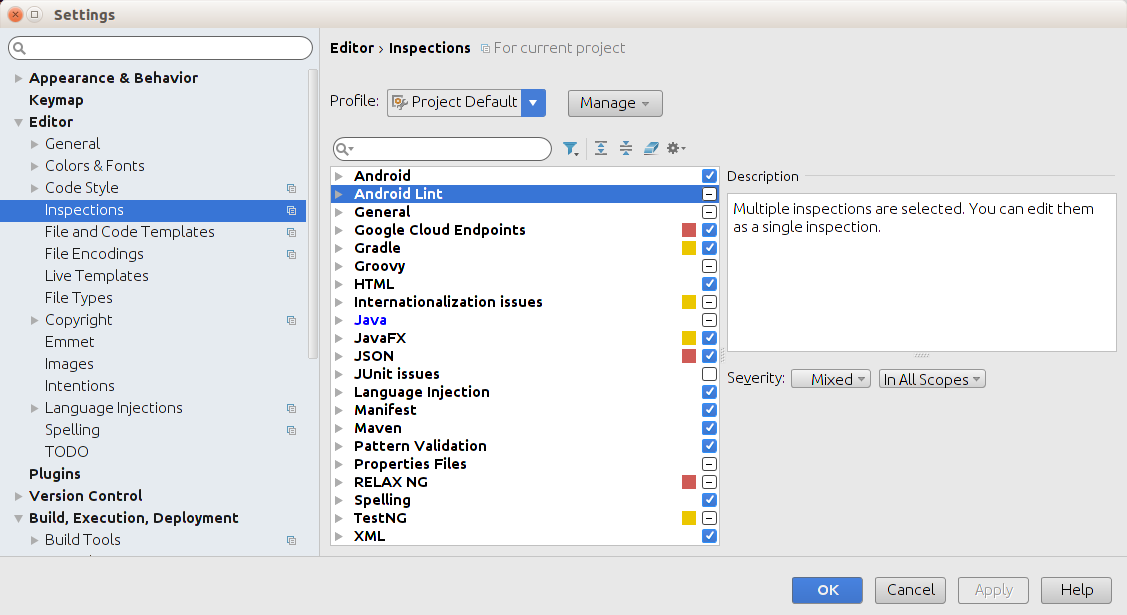In addition to testing that your Android application meets its functional requirements, it's important to ensure that your code has no structural problems. Poorly structured code can impact the reliability and efficiency of your Android apps and make your code harder to maintain. For example, if your XML resource files contain unused namespaces, this takes up space and incurs unnecessary processing. Other structural issues, such as use of deprecated elements or API calls that are not supported by the target API versions, might lead to code failing to run correctly.
Overview
The Android SDK provides a code scanning tool called lint
that can help you to easily identify and correct problems with the structural quality of your code, without having to execute the app or write any test cases. Each problem detected by the tool is reported with a description message and a severity level, so that you can quickly prioritize the critical improvements that need to be made. You can also configure a problem's severity level to ignore issues that are not relevant for your project, or raise the severity level. The tool has a command-line interface, so you can easily integrate it into your automated testing process.
The lint tool checks your Android project source files for potential bugs and optimization improvements for correctness, security, performance, usability, accessibility, and internationalization. You can run lint from the command-line or from Android Studio.
Note: In Android Studio, additional IntelliJ code inspections run when your code is compiled in Android Studio to streamline code review.
Figure 1 shows how the lint tool processes the application source files.

Figure 1. Code scanning workflow with the lint tool
- Application source files
- The source files consist of files that make up your Android project, including Java and XML files, icons, and ProGuard configuration files.
- The
lint.xmlfile - A configuration file that you can use to specify any
lintchecks that you want to exclude and to customize problem severity levels. - The
linttool - A static code scanning tool that you can run on your Android project from the command-line or Android Studio. The
linttool checks for structural code problems that could affect the quality and performance of your Android application. It is strongly recommended that you correct any errors thatlintdetects before publishing your application. - Results of
lintchecking - You can view the results from
lintin the console or in the Event Log in Android Studio. Each issue is identified by the location in the source files where it occurred and a description of the issue.
The lint tool is automatically installed as part of the Android SDK Tools revision 16 or higher.
Running lint in Android Studio
In Android Studio, the configured lint and
IDE inspections run automatically whenever you build your app. The IDE inspections are
configured along with the lint checks to run
IntelliJ code inspections to streamline code review.
Note: To view and modify inspection severity levels, use the File > Settings > Project Settings menu to open the Inspection Configuration page with a list of the supported inspections.
With Android Studio, you can also run lint inspections for a specific build variant,
or for all build variants from the build.gradle file. Add the
lintOptions property to the android settings in the build file.
This code snippet from a Gradle build file shows how to set the quiet option to
true and the abortOnError option to false.
android {
lintOptions {
// set to true to turn off analysis progress reporting by lint
quiet true
// if true, stop the gradle build if errors are found
abortOnError false
// if true, only report errors
ignoreWarnings true
}
...
}
To manually run inspections in Android Studio, from the application or right-click menu, choose Analyze > Inspect Code. The Specify Inspections Scope dialog appears so you can specify the desired inspection scope and profile.
Running lint from the Command-Line
To run lint against a list of files in a project directory:
lint [flags] <project directory>
For example, you can issue the following command to scan the files under the myproject directory and its subdirectories. The issue ID MissingPrefix tells lint to only scan for XML attributes that are missing the Android namespace prefix.
lint --check MissingPrefix myproject
To see the full list of flags and command-line arguments supported by the tool:
lint --help
Example lint output
The following example shows the console output when the lint command is run against a project called Earthquake.
$ lint Earthquake Scanning Earthquake: ............................................................................................................................... Scanning Earthquake (Phase 2): ....... AndroidManifest.xml:23: Warning: <uses-sdk> tag appears after <application> tag [ManifestOrder] <uses-sdk android:minSdkVersion="7" /> ^ AndroidManifest.xml:23: Warning: <uses-sdk> tag should specify a target API level (the highest verified version; when running on later versions, compatibility behaviors may be enabled) with android:targetSdkVersion="?" [UsesMinSdkAttributes] <uses-sdk android:minSdkVersion="7" /> ^ res/layout/preferences.xml: Warning: The resource R.layout.preferences appears to be unused [UnusedResources] res: Warning: Missing density variation folders in res: drawable-xhdpi [IconMissingDensityFolder] 0 errors, 4 warnings
The output above lists four warnings and no errors in this project. Three warnings (ManifestOrder, UsesMinSdkAttributes, and UsesMinSdkAttributes) were found in the project's AndroidManifest.xml file. The remaining warning (IconMissingDensityFolder) was found in the Preferences.xml layout file.
Configuring lint
By default, when you run a lint scan, the tool checks for all issues that are supported by lint. You can also restrict the issues for lint to check and assign the severity level for those issues. For example, you can disable lint checking for specific issues that are not relevant to your project and configure lint to report non-critical issues at a lower severity level.
You can configure lint checking at different levels:
- Globally, for the entire project
- Per project module
- Per production module
- Per test module
- Per open files
- Per class hierarchy
- Per Version Control System (VCS) scopes
Configuring lint in Android Studio
Android Studio allows you to enable or disable individual inspections and configure
project-global, directory-specific, and file-specific settings for lint.
You can manage inspection profiles and configure inspection severity within Android Studio using the File > Settings > Project Settings menu to open the Inspections page with a list of the supported profiles and inspections.

Figure 3. Inspection Configuration
Global preferences
- To specify global project settings, select the project folder in the Project View and choose Analyze > Inspect Code.
- Specify your inspection scope and profile, and click OK.
The configured settings run the specified lint inspections. The lint
inspections are also run whenever you build and run your Android project and modules.
Module and file-specific preferences
- Run the
linttool on your module by right-clicking on your module folder or file in the Project View and selecting Analyze > Inspect Code. This displays thelintinspection results with a list of issues thatlintdetected in your module. - From the Lint Warnings view, use the toolbar options to configure
lintpreferences for individual modules and files, and set the issue display options.
Configuring the lint file
You can specify your lint checking preferences in the lint.xml file. If you are creating this file manually, place it in the root directory of your Android project. If you are configuring lint preferences in Android Studio, the lint.xml file is automatically created and added to your Android project for you.
The lint.xml file consists of an enclosing <lint> parent tag that contains one or more children <issue> elements. Each <issue> is identified by a unique id attribute value, which is defined by lint.
<?xml version="1.0" encoding="UTF-8"?>
<lint>
<!-- list of issues to configure -->
</lint>
By setting the severity attribute value in the <issue> tag, you can disable lint checking for an issue or change the severity level for an issue.
Tip: To see the full list of issues supported by the lint tool and their corresponding issue IDs, run the lint --list command.
Sample lint.xml file
The following example shows the contents of a lint.xml file.
<?xml version="1.0" encoding="UTF-8"?>
<lint>
<!-- Disable the given check in this project -->
<issue id="IconMissingDensityFolder" severity="ignore" />
<!-- Ignore the ObsoleteLayoutParam issue in the specified files -->
<issue id="ObsoleteLayoutParam">
<ignore path="res/layout/activation.xml" />
<ignore path="res/layout-xlarge/activation.xml" />
</issue>
<!-- Ignore the UselessLeaf issue in the specified file -->
<issue id="UselessLeaf">
<ignore path="res/layout/main.xml" />
</issue>
<!-- Change the severity of hardcoded strings to "error" -->
<issue id="HardcodedText" severity="error" />
</lint>
Configuring lint checking in Java and XML source files
You can disable lint checking from your Java and XML source files.
Tip: If you are using Android Studio, you can use the
File > Settings > Project Settings > Inspections feature to manage the
lint checking to your Java or XML source files.
Configuring lint checking in Java
To disable lint checking specifically for a Java class or method in your Android project, add the @SuppressLint annotation to that Java code.
The following example shows how you can turn off lint checking for the NewApi issue in the onCreate method. The lint tool continues to check for the NewApi issue in other methods of this class.
@SuppressLint("NewApi")
@Override
public void onCreate(Bundle savedInstanceState) {
super.onCreate(savedInstanceState);
setContentView(R.layout.main);
The following example shows how to turn off lint checking for the ParserError issue in the FeedProvider class:
@SuppressLint("ParserError")
public class FeedProvider extends ContentProvider {
To suppress checking for all lint issues in the Java file, use the all keyword, like this:
@SuppressLint("all")
Configuring lint checking in XML
You can use the tools:ignore attribute to disable lint checking for specific sections of your XML files. In order for this attribute to be recognized by the lint tool, the following namespace value must be included in your XML file:
namespace xmlns:tools="http://schemas.android.com/tools"
The following example shows how you can turn off lint checking for the UnusedResources issue for the <LinearLayout> element of an XML layout file. The ignore attribute is inherited by the children elements of the parent element in which the attribute is declared. In this example, the lint check is also disabled for the child <TextView> element.
<LinearLayout
xmlns:android="http://schemas.android.com/apk/res/android"
xmlns:tools="http://schemas.android.com/tools"
tools:ignore="UnusedResources" >
<TextView
android:text="@string/auto_update_prompt" />
</LinearLayout>
To disable more than one issue, list the issues to disable in a comma-separated string. For example:
tools:ignore="NewApi,StringFormatInvalid"
To suppress checking for all lint issues in the XML element, use the all keyword, like this:
tools:ignore="all"